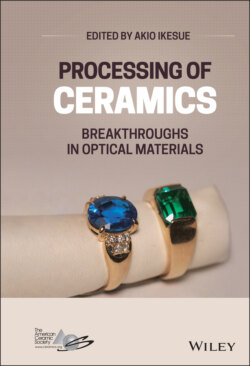Читать книгу Processing of Ceramics - Группа авторов - Страница 20
2.2 Principle of Laser Generation 2.2.1 Spontaneous Emission
ОглавлениеFirst, the fundamental part of the laser such as fluorescence generation and stimulated emission phenomenon will be explained. Transition metals such as Cr, Ti, Co, etc. or lanthanide rare earth elements such as Nd, Yb, etc. which participate in light emission are added to a general solid‐state laser gain medium. The light emission of Nd and Yb is described as a typical example relating to these laser emissions. Yb and Nd are known to be typical three and four‐level lasers, respectively.
Figure 2.1 shows an energy diagram of three and four‐level lasers. In a three‐level laser, when Yb electrons in the ground state are excited with 940 nm LD light, electrons are pumped up to the excitation level in Figure 2.1a, and the excited electrons are electronically transited to 2F5/2 at the lower level. Spontaneous emission (fluorescence emission) occurs from this level, but electrons return to the lower level 2F7/2 (ground state). This electron transition is called three‐level laser because it transits from the ground state ⇒ excitation ⇒ laser transition level as three steps. Due to the progress of LD (laser diode) technology in recent years, the LD of 970 nm has also been developed, and quantum limit efficiency (energy of generated laser/energy of input LD light) becomes 91% when excited with this LD.
Figure 2.1 Schematic energy diagram of (a) three‐level laser (Yb‐doped) and (b) four level laser (Nd‐doped).
Nd system is called a four‐level laser because it has four stages: ground state ⇒ excitation level ⇒ upper level ⇒ lower level ⇒ ground state (see Figure 2.1b). The laser cannot oscillate unless a population inversion (described later) finally occurs. In the case of a three‐level laser, the lower level is equal to the ground state; and in order to trigger population inversion, it is necessary to raise more than half of the doped Yb atoms to the excitation level, so that strong excitation is required. Therefore, LD excitation is an effective means. On the other hand, in the case of the Nd four‐level system, since the lower level is not in the ground state, the population inversion is easily generated, and laser can be easily generated even with a flash lamp. In the case of Nd, when the electrons in the ground state are excited to 4F5/2, the excited electrons are automatically firstly transferred to 4F3/2 to generate fluorescence. Since Nd has three lower levels, the electrons excited at 4F3/2 are transferred into three different lower levels; 4F3/2 ⇒ 4I9/2 (emission at 946 nm), 4F3/2 ⇒ 4I11/2 (emission at 1064 nm), and 4F3/2 ⇒ 4I13/2 (emission of 1.3 μm). The transition probabilities are 0.25, 0.60, and 0.15, respectively. Since the Nd system has four levels, strong excitation is not required, and a laser can be easily generated even with a xenon lamp excitation. However, since it is white light, the energy conversion efficiency is as low as about 3%. As in the Yb system, an 808 nm LD can pump electrons to 4F5/2 energy level in the Nd system; recently, it has become possible to pump directly to 4F3/2 energy level with an 885 nm LD to increase the pumping efficiency. Since the quantum limit efficiency of the Nd system is 74%, although laser generation is easy, there is a drawback that the efficiency is inferior to the Yb system.
